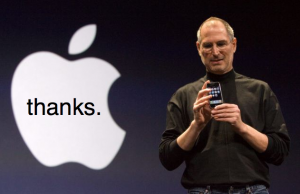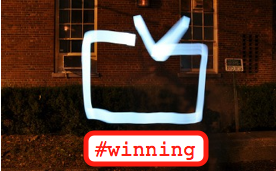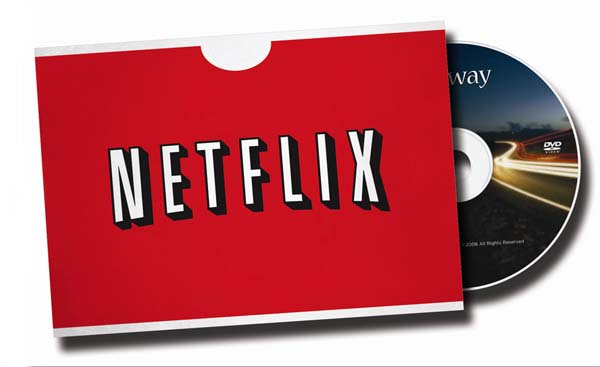 Apple is one of those companies that tends to polarize people. Some hate them for “closed” systems. Others love them for beautiful products. Some call them evil and bullying. Others say they open markets. I’m not one to debate, so I’ll just cut to the chase by saying Apple, in the past decade, has contributed more to consumer technology than most other companies combined. And it’s fairly hard to argue that the Apple of today is entirely the company Steve built.
Apple is one of those companies that tends to polarize people. Some hate them for “closed” systems. Others love them for beautiful products. Some call them evil and bullying. Others say they open markets. I’m not one to debate, so I’ll just cut to the chase by saying Apple, in the past decade, has contributed more to consumer technology than most other companies combined. And it’s fairly hard to argue that the Apple of today is entirely the company Steve built.
Steve Jobs’ resignation hits hard, but the only thing that comes as a surprise is the seeming suddenness of it (Yeah, but I mean the very end, when he actually resigned. That was extremely sudden). Here’s a list of some of the things, love em or hate em, that we should all be thankful of Jobs/Apple for (and yes, I’m sure some dude in some lab somewhere invented all these things about 300 years ago, but if it weren’t for Apple, we all wouldn’t know about them):
- Internet-based music distribution: from iTunes to Pandora to Spotify to Turntable, had it not been for Apple creating the iPod+iTunes ecosystem, it’s unlikely the music industry would’ve had sufficient motivation to enable “digital” as fast as they did. The MP3 market would’ve grown much slower, resulting in less buy-in from the industry, resulting in a lack of streaming and on-demand services. Would we have something like it today? Probably. Would it all be priced the way it is today? Doubtful. It took the muscle of the iPod’s dominance to enable Apple to negotiate the entire music industry into the $0.99 pricing schema we have today. It’s likely that companies such as Amazon and Sony would’ve ended up much strong in this space, but we’d probably be paying more for the same content, and I’d wager services like Pandora would never have gotten off the ground.
- “Real” smartphones: Unquestionably smartphones predate the iPhone. Blackberries had some “smartness” and earlier generation Windows Mobile devices actually provided quite a bit of functionality, not to mention the granddaddy of them all, the Palm/Treo lines. But let’s face it, the iPhone really changed everything. Capacitive touchscreens (remember the stylus? nope, me neither), app stores (more on that to come), and more, all thanks to the iPhone’s success. I think Nokia and RIM would still be considered the leaders in the mobile space if Apple had never shipped an iPhone, and team Android should be exceptionally grateful for its existence.
- Gestures: Pinch + Zoom? Swipe? Multi-finger scroll? One could argue this is just a subset of the smartphone, but it’s not, as gesture support has improved the computing experience overall. Prior to the “two finger scroll” feature on MacBooks, the only thing even close was the variety of PC manufacturers who enabled the right-side scroll region on their inputs. Once again, an area where numerous companies could’ve beaten Apple to the punch, but simply didn’t.
- The Internet: Just kidding.
-
Bringing Sexy Back: From the moment Steve rejoined Apple through to today, the company’s products have set the standard for technology aesthetics. Whether it’s the sleek industrial design, the minimalistic approach, the amazing attention to detail, or the use of aluminium, it’s as if Apple showed up in a Porsche while everyone around them were driving Volvos (boxy, but good). As a result, there’s been an almost frenetic rush to make distinctive, beautiful technology. And some of it’s even been pretty good!
- Changing Retail: When Apple first announced they’d open their own retail stores, they were literally laughed at. There’s now over 300 of them, and they are unbelievably successful. They are considered the best retail customer experience overall. They are wildly profitable. Consumers enjoy going there even when they don’t buy things. In fact, my only surprise here is the lack of copycats – nobody’s even close to creating a similar experience at such a grand level. Well, maybe in China…
- The App Economy: Yes, my PalmPilot had installable apps, and so did my Windows Mobile phone. But it took Apple to create a nearly $4-BILLION app economy and marketplace. My hunch here is without Apple revolutionizing the concept (by, again, creating a full end-to-end experience regarding discovery, installation, and most importantly, payment, for apps), we’d have nothing even as advanced as the Android market is today, which I still consider to be floundering in the dust relatively (simple tip to radically improve said experience: sort all apps AND reviews by device – will fix 80% of fragmentation problems in one fell swoop).
- The iPad: Remember when tablets really sucked? Guess what, they still do. But what doesn’t suck is the iPad. Other than speculation and conjecture, the reality check is the only successful “tablet-like product” on the market is the iPad, all others pale in comparison. I could write a dozen or so blog posts on what everybody else is doing wrong, but the thing that matters here is all the things Apple did right. They made something that perfectly fits into a few dozen million peoples’ lives. Flash? Nobody cares. USB? Nobody cares. “Closed system”? Nobody cares. The iPad, as if by magic, navigated through the waters of touch-input devices to create the admittedly-not-perfect product, but so far beyond “good enough” that it’s changed computing as we know it.
I’m sure I’m missing a bunch of things that the company did that I can’t even recall at this moment, but these were the ones that hit me as most important. How did they do it? The comfort in saying “no, we can’t ship that yet, it’s just not ready.” The comfort in saying “it’s okay if we aren’t providing every feature known to man, just so long as our features are great.” The comfort in saying “we don’t have to be perfectly compatible with all other technologies that have come before us, if we make a strong ecosystem ourselves.” The comfort in saying “we believe this is what people really want, and we’re going to give it to them.”
These are statements that no other technology manufacturer or provider make, so far as I’ve seen in my career (with brief exceptions, such as Sling, Flip, and a handful of others).
When Steve Jobs rejoined Apple in the late 90s, it’s well known that he rapidly ripped apart products, cut staff, and trimmed down the entire operation to get radically focused. Since then, beyond all the technology and products, what Steve’s done the most is built the very DNA of the Apple that we know today. The real contribution Steve made, in my opinion, was creating a culture of building to perfection, and understanding what that means as a core essence.
As I commented on TechCrunch, “Much like when a pitcher walks from the mound, the entire tech industry should stand and give a round of applause for one who has contributed so much.”

Time to call it a day
When a pitcher takes that walk, sometimes it’s because they’re pulled. But every now and then, that pitcher gave his all, kicked some amazing ass, and it’s just time for him to take a rest. But along the way he carried or maybe even made the game. And his spirit carries the team even further. And for those of us watching on the sidelines, we rise with applause, out of thanks and respect.

You rocked our world!
And then the game carries on.

 I’ve been in “Future of TV” startups directly and indirectly since 1999, yet haven’t once made it to SXSW Interactive (I was even supposed to speak this year, but my third child arrived way too close to the conference for me to make it unfortunately). For 2012 I’ve proposed a talk entitled “Why the Future of TV has Four Screens” and hopefully the conference organizers will find it interesting to include. This is obviously a space I have a lot of passion about, so I decided to go peek around at what other interesting and related presentations and panels are in the “PanelPicker”.
I’ve been in “Future of TV” startups directly and indirectly since 1999, yet haven’t once made it to SXSW Interactive (I was even supposed to speak this year, but my third child arrived way too close to the conference for me to make it unfortunately). For 2012 I’ve proposed a talk entitled “Why the Future of TV has Four Screens” and hopefully the conference organizers will find it interesting to include. This is obviously a space I have a lot of passion about, so I decided to go peek around at what other interesting and related presentations and panels are in the “PanelPicker”.








